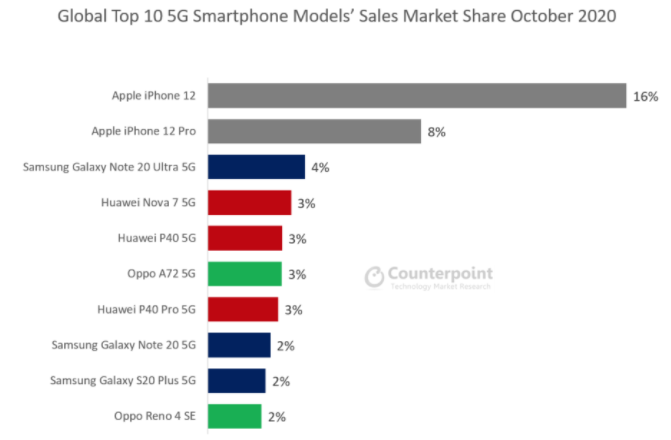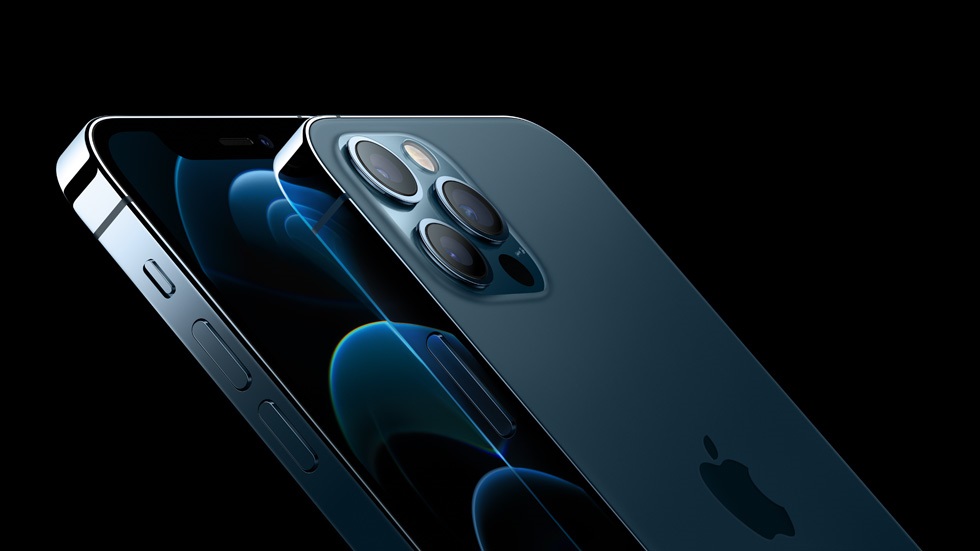- Apple’s iPhone 12 quickly became the most popular 5G smartphone on the market following its October release.
- Together with the iPhone 12 Pro, Apple devices currently enjoy a 24% share of the 5G smartphone market.
- iPhone 12 demand is so strong that Apple recently ordered suppliers to boost production by 30%.
Apple’s iPhone 12 may not have been the first 5G-equipped smartphone to hit the market, but the next-gen device needed less than two weeks to become the most widely-used 5G smartphone on the planet. According to a new report from Counterpoint Research, the iPhone 12 currently accounts for 16% of all 5G smartphones as of October 2020. When coupled with the iPhone 12 Pro, Apple’s share of the 5G smartphone market jumps to 24%.
All the more impressive is that Apple’s iPhone 12 didn’t even launch until late October, and yet it still managed to attain a higher market share than Samsung devices — such as the Galaxy Note 20 Ultra 5G and the Galaxy S20 Plus 5G — that hit the market months beforehand.
The research report attributes the iPhone 12’s popularity to “pent-up demand” for 5G connectivity amongst existing iPhone users.
The report adds:
This was complemented by strong carrier promos, especially in the US, which accounted for over one-third of the iPhone 12 and 12 Pro sales for the month. All carriers were offering the iPhone 12 for $0 through a mix of the trade-in and unlimited plans.
China and Japan also saw strong initial demand for the iPhone 12 series. Compared to most of the other 5G models, which have a regional presence, the iPhone 12 has a wider market coverage – it is available in over 140 countries, thus helping sales.
The breakdown of smartphone 5G market share breaks down as follows:

The fact that the iPhone 12 managed to garner a nearly 25% market share in less than two weeks is perhaps not surprising given previous reports we’ve seen regarding demand for the device.
Just last week, a Nikkei report — citing supply chain sources, of course — relayed that iPhone production during the first half of 2021 is slated to be 30% higher than it was in 2020. Note that this figure includes non-iPhone 12 devices such as the iPhone SE:
The Cupertino-based tech giant has asked suppliers to build some 95 million to 96 million iPhones, including the latest iPhone 12 range and the older iPhone 11 and iPhone SE, multiple people familiar with the matter told Nikkei Asia — though industrywide shortages of key components could threaten that target.
All told, Nikkei estimates that iPhone production for the entire year could reach 230 million units, a figure that’s 20% higher than Apple’s iPhone production last year.
Apple doesn’t breakdown iPhone sales figures across different models, but the report relays that demand for the iPhone 12 Pro and iPhone 12 Pro Max are particularly strong and above Apple’s initial forecasts. The iPhone 12 Mini, meanwhile, is reportedly underperforming relative to Apple’s initial projections. iPhone 12 Mini demand, it’s worth noting, might have been adversely impacted by the April release of the iPhone SE since both devices boast compact form factors.
We’ll have a clearer picture of iPhone 12 sales when Apple posts its earnings report for the holiday quarter late next month.








